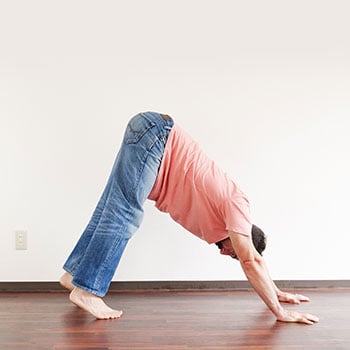Why You Should Care About Autoregulation
You want to make every workout count, so you push yourself to the limit as much as possible. How else will you keep making gains?
 Unfortunately, that’s a recipe for getting burnt out, or worse, hurting yourself.But it’d be too simple, and wrong, to think that auto regulation is:
Unfortunately, that’s a recipe for getting burnt out, or worse, hurting yourself.But it’d be too simple, and wrong, to think that auto regulation is:
“Just take it easy when you don’t feel well”
If it were that, then you wouldn’t need to learn what we’ll be talking about here. Which boils down to knowing how to do the right amount of work, in the right way for what you need today.
When you understand and do this, you can’t help but improve. When you don’t you’ll keep keep veering from burning out to not doing enough. It’s time to get off the roller coaster that prevents you from being your best.
I get it, I’ve been there. I’ve been on a quest to be find my physical bests since I was a teenager and I love plans. Nothing wrong with it at all, a well thought out program and all the details can take you very far. Unfortunately, I got so enamored with a few regimens because of how great I felt. Until suddenly I didn’t…
I followed each set and rep and weight to the letter. No matter how I felt. And in your mid 20s, you can do that for a pretty long time. Then I ran into the wall. Lather, rinse, repeat. I did that quite a few times until I finally figured out a better way.
Remember the plan has to serve you, you are not supposed to cram yourself into a box, no matter how perfect it is.
The purpose of any kind of training is to help make you better. Move better, feel better, react better, understand better. And it cannot do that if you are too rigid with yourself and ignore when you should change things up. But maybe the best thing that happens, is that you learn that you really can trust yourself to make the best decisions.
Autoregulation, done correctly, gets you trusting yourself, training smarter, and achieving the best results possible.
What Autoregulation is and Why You Need it
 Autoregulation is a fancy term in the research for adjusting your workload and how hard you’re going at it in each training session.
Autoregulation is a fancy term in the research for adjusting your workload and how hard you’re going at it in each training session.
It isn’t just about how you “feel,” but is based on your actual performance. That is how you are actually doing relative to how you’ve performed the exercises/movements before.
You change your intensity and volume of today’s training according to how you are doing right now, not how you “should be” or what’s in the written plan for the day.
Sometimes, this will mean pulling back your workload if your reps aren’t feeling snappy and strong like they did at your last workout, even with the same loads or exercise variations.
This can take some getting used to if you’re used to pushing yourself to the limit each and every workout. But think of this way, when you drive to get somewhere you can’t always hit turbo boost down the highway. You slow down and speed up as the conditions change, you know how to drive smart and safe and still make it to where you’re going on time. It doesn’t make sense to drive too fast or too slow, you drive exactly the speed you need to depending on the situation.
And just like you learned how to do that when you started driving, you’ll develop the skill of autoregulation through practice and time. It’s a learnable skill that you will improve over time.
Let’s make it perfectly clear. It’s a skill not a feeling.
The 3-Step Autoregulation Framework
Let’s get you started right away with this three step process, it’ll only seem complicated at first, but like everything else we practice, after a couple times it will start to click. But you have to start!
1. Assess
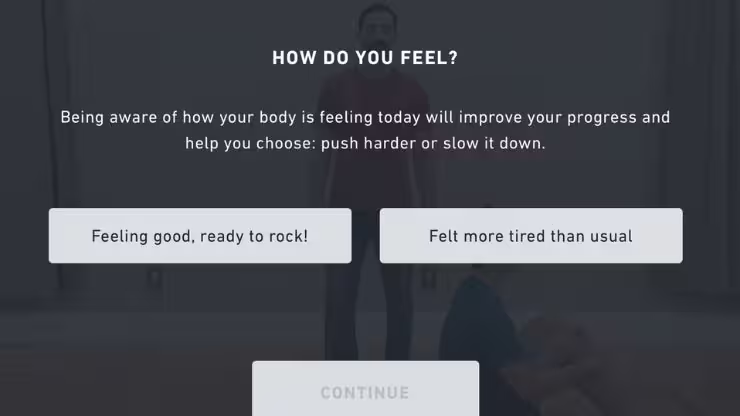 As you start your session, take a minute or two to check in and see how you’re feeling.
As you start your session, take a minute or two to check in and see how you’re feeling.
Checklist:
- Did you get your usual quality of sleep last night?
- Do your muscles feel sore/tight?
- Have you had enough to eat and/or drink today?
- Any other major stress preoccupying you?
We always recommend using your warm-up as a way to prepare yourself for your session in this way. You’re likely going to warm-up anyway, so it’s the perfect opportunity to check in and assess how you’re doing.
But keep in mind that the way you’re feeling at the start of your session is not the only thing that determines how, or if, you’ll adjust your training. It’s primarily how you are performing. Feeling worn down could affect your performance for sure, but you really won’t know until you start.
You don’t have to feel amazing in every session to improve, that’s just unrealistic! You can absolutely have a very good workout while not feeling 100 percent. You just have to adjust accordingly.
Assessment shouldn’t happen just the one time when you start, but basically after every movement you do you should be gathering information. It may seem like a lot at the start but you’ll get the hang of it.
2. Adjust
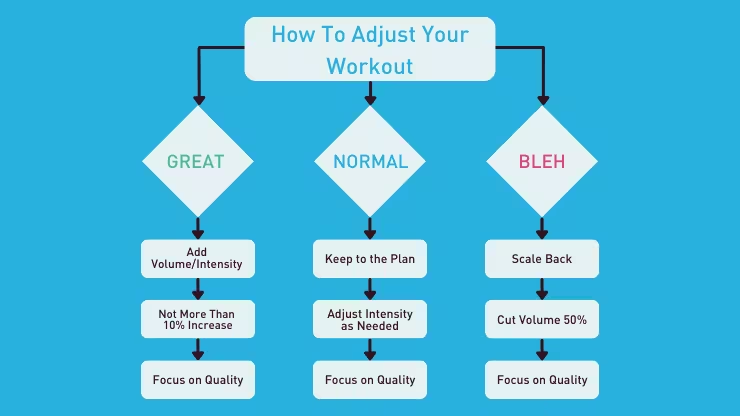
Now, here’s the meat of the practice, as you can see in the chart there’s basically three options to choose from. Do more, stick to the plan, and cut back a bit.
When to Do More
If you feel great *and* the work feels easier than last time, it’s a good sign to push a little. But don’t go all out. A smart approach is to increase volume (time, reps) or load (weight, resistance) by no more than 10% per session. For example, you’ve started a set of jumps and it’s like you’re light as a feather! You’re scheduled to do 5 sets of 12 jumps (that’s 60 total), instead of bumping that up to 20 jumps a set, add just one rep to each set. It’ll feel like you are holding back, because you are! And remember that’s just for one exercise, you can increase up to 10% for each move you’re doing for the day, and it will add up.
Don’t beat yourself up when you’re feeling great, that’s silly. Push a bit more, enjoy the feeling and set yourself up well for the upcoming workouts. You’re not trying to win the day, you want to win the years.
When to Do Less
If you feel off and everything feels harder than usual, scale back. For example, if it normally takes 5 minutes of straight locomotions before you start to feel fatigued but today you feel nearly wiped out in 2 minutes, or if 5 pull-ups usually feel easy but today the first one is a struggle—it’s time to dial it down.
Listen to both your body and the numbers, and adjust accordingly.
My rule of thumb is to cut your usual volume of activity in half. You could end up doing more, but see how that half goes, it might be just right for you.
Above all, keep your focus on movement quality. Whether you’re feeling great or just happy you showed up, don’t be sloppy! Practice how you want to be, because that’s how it’ll happen.
3. Apply
 And here this is simply doing the work. Assess and Adjust throughout your session and do the work as best you can. This is the formula for progress!
And here this is simply doing the work. Assess and Adjust throughout your session and do the work as best you can. This is the formula for progress!
Now to make it even better, so that you can optimize your learning and very likely discover your own patterns.
You this by dedicating some time for self-reflection.
Reflection doesn’t have to mean writing pages and pages about your session, but it’s a good idea to jot down a few notes.
Here are some ideas you can reflect on:
- How did you feel your session went compared to how you thought it was going to go at the start of the session?
- Were you pleasantly (or unpleasantly) surprised by your performance?
- Did you learn anything that you want to remind yourself about next time?
This will help you compare your next session to this one so you can better gauge how you’re performing.
Remember this is the key to auto-regulation, not just how you are feeling but how youare actually performing.
Common Mental Barriers to Autoregulation
We’re all used to the difficulties of starting a new routine. But once you get past the first few weeks and get into the groove and rhythm of your routine, it just feels easier and you get better and better. But this can’t last forever, of course, and you hit a bad training session or two. The easy answer might seem to be PUSH HARDER because this is what bombards us every time we look at fitness social media.
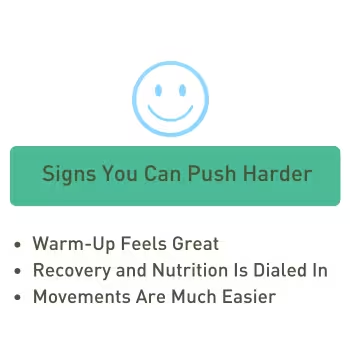 But what if I don’t push hard enough?
But what if I don’t push hard enough?
I can’t say that won’t be the case sometimes, but I can say it won’t be the answer every time! It is much too simple to say that you should always do more or always do less. But that doesn’t make any sense, and you probably know that deep down anyway. We all have our tendencies, either being a Type A person who’s always pushing or maybe you’d rather be relaxing most of the time. Both of those aren’t what we want.
Proper autoregulation is about maximizing the right stimulus at the right time.
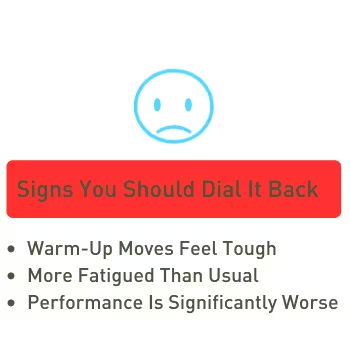 I feel guilty if I don’t go all-out.
I feel guilty if I don’t go all-out.
This is good to know! It’s an incorrect feeling but understanding that this is your tendency is helpful. It just means that you want to do the best for yourself and right now that’s associated with working as hard as you can. This can be a great thing for sure, but look at the heart of what you want. It’s not about being as intense as you can in every workout. It’s about what you need to do to actually get better and improve your health and fitness.
And I think you know the answer for that, it’s long-term consistency doing the appropriate work over years and years. This simply cannot happen with 100 percent intensity at every session.
I don’t trust myself to make good decisions.
This is another very natural feeling, we aren’t all professional trainers and athletes. So how can we know what’s best for us? Well you won’t right away, there will be lots of trial and error. That’s how learning goes, and that’s how it goes with anything worth our while.
You’ll get better with practice—start simple, refine over time. Riding a bike may have seemed impossible, hopping on roller skates, strapping on skis, and a dozen other examples of what we’ve done over the years. The same with learning how to do this.
Trust the process and learn to trust yourself. It’ll be worth it.
GMB Elements Built-In Autoregulation Helps You Stay On Course
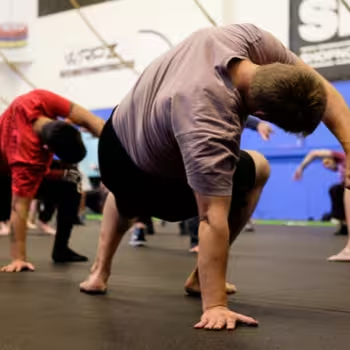 Our Elements program has all of what we’ve just talked about built into it, where you are guided and actively encouraged to practice and learn how to do what’s best for you. You adjust your training based on how you are performing that day—no rigid schedules or fixed rep counts. Instead, it’s all about understanding where you are in the moment and doing what’s optimal for you.
Our Elements program has all of what we’ve just talked about built into it, where you are guided and actively encouraged to practice and learn how to do what’s best for you. You adjust your training based on how you are performing that day—no rigid schedules or fixed rep counts. Instead, it’s all about understanding where you are in the moment and doing what’s optimal for you.
No fixed rep counts
You’re not chasing arbitrary numbers. Instead, you focus on how each movement feels. If your form starts to slip, that’s your cue to adjust.
Daily adaptability
Your body isn’t the same every day—some days you’re on fire, other days it’s enough to just show up and do what you can. Elements teaches you how to listen and heed to your body’s signals.
You’ll see that when you’re doing it right, you’ll naturally have ebbs and flows in your performance–just like we have ebbs and flows in other areas of our life as well. But even with a lot more “low” days than you might have with a maximal effort training program, the overall trajectory will be steady progress over time.
And that’s the beauty of autoregulation. You don’t need to predict it beforehand, you simply evaluate as you get into the workout and do your first few sets.
🔑 If You’re Feeling Great
Challenge yourself with more difficult movement variations.
Add a bit more time or an extra set if your form stays solid.
Explore faster tempos or transitions to increase intensity while keeping control.
😴 If You’re Stiff or Tired:
Slow down the pace and focus on precision in each movement.
Reduce the range of motion if needed—keep things smooth, not forced.
Spend extra time in easier variations to work through tightness without overloading yourself.
Doing all this helps you train consistently without burning out, making every session productive—whether you’re pushing hard or easing off. When you use autoregulation to adjust your workload with each training session to match that day’s performance, your progress may not be as steep, but it will be much more steady and reliable.
Let go of your expectations and head into day’s training without any preconceived notion of whether it’s going to be good or bad. This helps you to train hard and really push it when it feels right or take a pause and scale down when necessary.
Autoregulation in Action: Know When to Go Low and When to Go High
One thing autoregulation isn’t is skipping training sessions just because you don’t feel 100%. So we built Low-Intensity Sessions into our programs to give you the best options.
Here’s two examples of low-intensity bodyweight strength workouts:
Though we created custom software to build autoregulation into our training curriculum, you can use the same strategy to improve your progress with just about any program. You just need to practice assessing your readiness and performance so you can learn to adjust the intensity of your workouts.
And remember, another thing it isn’t is just knowing when to do less, it’s knowing what’s best for you that day and it could be challenging yourself!
In it for the Long Haul
Autoregulation isn’t about passing or failing—it’s a skill you develop over time. The goal isn’t perfection. It’s learning to listen to your body, make informed adjustments, and train smarter. Like any skill, the more you practice it, the better you’ll get—and the more confidence you’ll have in making decisions that serve you long-term.
Ready to put this into action? In your next training session, take just two minutes before you start:
 Assess: How do you feel physically and mentally? Energized or sluggish? Movements feel tougher or easier than usual?
Assess: How do you feel physically and mentally? Energized or sluggish? Movements feel tougher or easier than usual?
Adjust: Based on that check-in, decide how to approach the session. Feeling strong? Give yourself a bit of a push Feeling off? Back down a little and emphasize quality movement.
Apply: Stick to your decision and apply what you’ve learned here and take notes! It really does help you in the long term
Here’s the truth: Master autoregulation, and you’ll never need another training plan to tell you what to do. You’ll know exactly what your body needs—today, tomorrow, and years from now. This is how you build consistency, resilience, and long-term progress—on your own terms.
Elements uses 4 fundamental locomotor movements with multiple variations of each to improve the breadth of your physical capacity. This variety and progression builds up your strength, mobility, and body control while also giving you the practice you need to know just when to push and when to scale back.
Build a Consistent Training Habit With a Foundation in the Basics
With Elements, you’ll build a foundation of strength, flexibility, and control using the Bear, Monkey, Frogger, and Crab.

